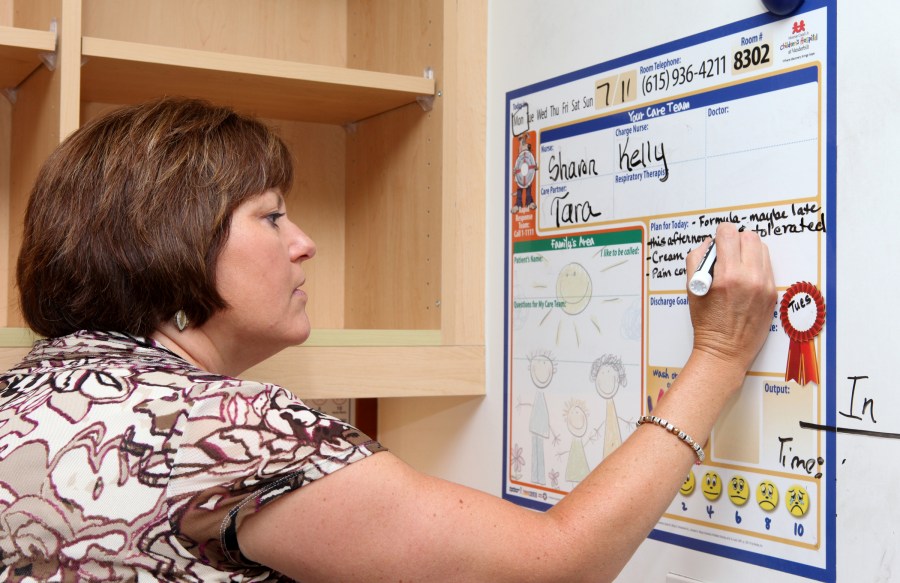
Traci Morgan, APRN, left, and Kelly Rudd, R.N., do discharge rounds with month-old Tanner Brown and his family at the Monroe Carell Jr. Children’s Hospital at Vanderbilt as part of a new program to increase effective communication. (photo by Susan Urmy)
New rounding initiative enhances communication
Effective communication with patients and families is a top priority for Vanderbilt University Medical Center Nursing, and another big reason why the Medical Center is deserving of a second Magnet designation.
A good example is the “Plan for the Day, Plan for the Stay” initiative that is making a difference in the lives of children recovering from general pediatric surgeries at the Monroe Carell Jr. Children's Hospital at Vanderbilt.

According to Vicki Jones, BSN, R.N., manager, 8th floor at Children’s Hospital, nurses were asked by hospital leaders, including Meg Rush, M.D., chief of staff and acting chair of the Department of Pediatrics, and Susan Hernandez, MBA, R.N., associate hospital director of nursing, to develop rounds that would help improve quality of care while potentially reducing the length of stay for patients.
Nurse practitioner Traci Morgan, MSN, APRN, case manager Brenda Frank, MSN, R.N., unit manager Vicki Jones and nurse educator Jan Malone, BSN, R.N., discussed the best approaches and completed a literature review in April.
“After gaining support from Dai Chung, M.D., chair of Pediatric Surgery, we decided to focus on more effective discharge planning through morning rounds,” said Jones. “These rounds focus on the concerns of the family and nurse as well as the goals for the day and discharge.”
The rounding team consists of a nurse manager, nurse practitioner, charge nurse, bedside nurse and case manager, and each day at 9 a.m. they convene to round on the general pediatric surgery patients.
The manager introduces the “Plan for the Day, Plan for the Stay” approach to the patient and the patient’s family. Any concerns of family members and nurses are discussed and addressed. The combined team, including the patient and family, determines goals along with a plan for discharge.
All the goals are written on the whiteboard for family viewing and communication with other members of the team. Discussion points include vital signs, pain management, nutrition, social issues and medications.
Before the new process started in February, Jones and her team surveyed the nursing staff to determine how they felt about their current knowledge level regarding the plan of care, inclusion in the plan of care and comfort level rounding with physicians. Staff nurses were crucial in identifying and working through potential barriers.

Brenda Frank, MSN, R.N., writes the daily goals on a patient’s white board, a key part of the new rounding system. (photo by Susan Urmy)
Data is still being collected on how “Plan for the Day, Plan for the Stay” may be impacting patient length of stay, where even shaving off a few hours can reduce medical costs to the family. However, there’s no question that the new approach is making families happier.
On a recent survey, one family commented “this is the best communication we have received during any of our hospitalizations.”
Many families have responded that they feel more involved in their loved one’s care and that the program has better prepared them for discharge and how to take care of their family member once at home.
“There is a huge benefit for patients and their families to have a clear understanding of their care,” Jones said. “We have about 100 general pediatric surgery patients a month in our area, and the most important thing in this whole process is for each of them to feel that they played an important role in their health care plan.”













